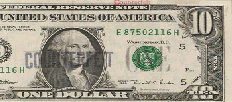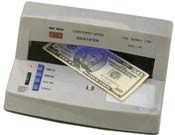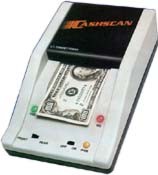Back To Buyer's Guide
 What are Bill Counters?
What are Bill Counters?
Bill Counters save time and increase accuracy by counting stacks of currency, checks, or coupons. They eliminate errors caused by manually counting each bill piece by piece. Material is placed in to the tray of the counter and the machine takes the money up through the machine, counting, batching, adding, and, in some machines, even detecting for legitimacy. Some machines are designed to exclusively handle US currency, while others can be used all around the world. Each machine is designed with a type of currency in mind and separate levels of security.
Finding the Right Bill Counter Types of Counterfeit Detection Found in Bill Counter Models
Types of Counterfeit Detection Found in Bill Counter Models
Ultra Violet Light Detector
Ultra violet light is used to detect the range of invisible radiation wavelengths shorter than violet in the invisible spectrum. Here's how it works:
With advances in copier and laser printing technology it has become easier than ever for individuals to create high-resolution replications of a wide range of currency. When currency is created in this method, the image is resting on the surface of the paper and can be detected once ultra violet light is run over the paper. It works like x-ray vision to zone in on questionable areas. Small particles of toner can be seen placed outside the standard image, thus indicating that it is NOT a valid currency.
Machines with UV detection scan each piece of currency for these inconsistencies inside the machine; you won???t even see this going on. Once a fake note is found, the information will automatically display on the window to notify the operator immediately. Some machines will sound an audible or visual alarm, while others simply produce small lights or provide information to be read off the display. Each machine manufactured with UV sensors has a different method of notifying the user of the types of detection it finds.
Magnetic Sensors
Magnetic sensors run over each bill and are designed to search for certain components of banknotes that cannot be seen by the naked eye. Machines automatically detect and match the piece against the already programmed components of a legitimate bill. Once a suspicious note is found, each machine has its own unique way of notifying the user.
Length Detector
Standard length detectors were first used to accurately measure currency to ensure that the dimensions match legitimate US bills. Length detectors notify you of worn, torn, or mutilated currency. It is important to detect these types of inconsistencies in your currency, because although they make not be fake notes created by an individual, the bill may be too damaged to accept for its intrinsic value. Since the Treasury Department will replace any clearly fragmented or mutilated currency as long as it is partially intact, you will want to identify the bills that need to be replaced. If the banknote is more than halfway torn, it is no longer a valid currency.
Machines with standard length detection scan each piece of currency for accurate dimensions. Once an inconsistent bill is found, for whatever reason, the machine will automatically display this information via a viewer window. Since each machine is built to notify the operator using different methods, you will want to make sure that you understand whether the machine will sound an alarm or visually display the information.
Length detection is USUALLY designed to handle US currency only.
Length and Width Detector
Length and width detectors were designed as a modification to the standard length detection. This modification enables the machine to detect different size currency for each country around the world. These machines work the same way as length detectors, except they need to be programmed or set to the dimensions of the bill that it is going to detect. Each machine will have a separate method of programming this information, but all are easy-to-use and set-up.
For maximum security, choose a machine that has all detection options.
http://www.treas.gov/usss/index.htm?money_characteristics.htm
 What are Counterfeit Detectors?
Counterfeit detectors are specialized units designed to scan individual banknotes for legitimacy through various detection methods, so you can protect the money that passes through your hands and ensure its value. Each bill is placed in to the machine by an operator who then selects the type of detection they want the machine to use. The types of detection options found on counterfeit detectors are ultraviolet light detection, incandescent bulb for watermark verification, magnetic head detection system, magnifier for micro-printing verification, lighted reflector to spot the color-shifting ink property and detector pen for chemical testing the bill paper.
What are Counterfeit Detectors?
Counterfeit detectors are specialized units designed to scan individual banknotes for legitimacy through various detection methods, so you can protect the money that passes through your hands and ensure its value. Each bill is placed in to the machine by an operator who then selects the type of detection they want the machine to use. The types of detection options found on counterfeit detectors are ultraviolet light detection, incandescent bulb for watermark verification, magnetic head detection system, magnifier for micro-printing verification, lighted reflector to spot the color-shifting ink property and detector pen for chemical testing the bill paper.
All of these detection options work alone or together to help pinpoint any questionable bills.
 Finding the Right Counterfeit Detector
Finding the Right Counterfeit Detector
How would you like to be notified of a counterfeit detection?
Some machines are low-key; they simply flash a red or green light on a digital display to indicate whether a bill is false (red) or legitimate (green), while other machines sound all types of audible alarms to draw attention to the fake bill.
What is the level of security you need to feel confident that your money is protected?
There is a counterfeit unit designed for every degree of protection to ensure that your money remains secure for years to come. See options below under the heading, "Types of Counterfeit Detectors", to pinpoint the level that is right for you.
Types of Counterfeit Detectors
Ultra Violet Light Detector (see UV detection above)
When fake currency is created using a color copier or printer, the image remains resting on the surface of the paper and can be detected once ultra violet light is run over the paper. It works like x-ray vision to zone in on questionable areas. Small particles of toner can be seen placed outside the standard image, thus indicating that it is NOT a valid currency.
In a counterfeit detection unit, fluorescence (or UV light) is emitted from inside the machine. Once a bill is placed underneath the lights, any inconsistencies in the bill are highlighted, notifying the user of whether the bill is counterfeit or "real". In most counterfeit detection units, the UV light reflects onto a sensor that initiates an audible or visual alarm. If the alarm is triggered, the operator knows that the bill or document is counterfeit or "suspicious". UV detection is not only used on currency, but also detects legitimate passports, credit cards and other personal documents.
Magnetic Detector
Magnetic detectors help to find counterfeit notes by searching the bill for the magnetic components used in the manufacturing of US and other foreign currencies, travelers checks, credit cards and more. In a counterfeit detection unit, the magnetic detector is usually located outside of the machine, and requires an operator to run each bill over the sensor head. For US bills, the face of the bill should redeem a positive magnetic reaction from the detector but the Federal Reserve emblem should scan as a negative magnetism. By rubbing this part of the bill over the sensor, the machine will detect the magnetic charge of any given area.
Magnifying Detector
On each banknote there are special markings or prints imbedded into the bill that cannot be seen by the naked eye alone. Detection units provide magnifying detectors to help you look for these special characteristics. The Federal Reserve suggests you pay attention to the type of note, portrait (size and position), micro printing, fine-line printing pattern consistent with legitimate bills, serial number, check letter and quadrant number, federal reserve seal, inscribed security thread (visual with UV or chemical test), federal reserve letter and number, series and the treasury seal.
For more details on what you should be looking for with the magnifiers, visit:
http://www.treas.gov/usss/index.htm?money_characteristics.htm
Watermark Detector
A watermark is a special marking found on the paper used to make US currency that is made as a result of the differences in thickness usually produced by pressure of a projecting design in the bill mold or on a processing roll. Once the suspicious note is held up to a fluorescent bulb or light the watermark becomes visible. In the counterfeit units, simply place each bill over the display of the fluorescent bulb and you will be able to view the position and quality of the watermark impression. A weak or poor quality watermark indicates that the banknote is a fake.
Lighted Reflector
A lighted reflector can be installed in to a unit to highlight the lower right hand corner on the front of a bill. This portion of a legitimate currency has a unique color-shifting property that changes color as you change the position of the bill, turning the color from green to black or black to green. If the lighted reflector does not find this property once the area has been isolated, the bill is counterfeit.
Glossary
Bill Counters save time and increase accuracy by counting stacks of currency, checks, or coupons. They eliminate errors caused by manually counting each bill piece by piece. Material is placed in to the tray of the counter and the machine takes the money up through the machine, counting, batching, adding, and, in some machines, even detecting for legitimacy. Some machines are designed to exclusively handle US currency, while others can be used all around the world. Each machine is designed with a type of currency in mind and separate levels of security.
Finding the Right Bill Counter
-
What type of material do I need to be counted?
Bill counters not only have the capability to count currency. Some machines count coupons, checks, or other documents that meet the machine???s size requirements. One major difference between bill counters is its ability to process US banknotes versus banknotes from around the world. Machines that can handle International currency come with digital options to customize the counter to the length and width of the bill you need to be counted.
-
How many bills do I need to process at a time and at what speed?
Each machine is designed to process a certain amount of banknotes per minute. The amount of banknotes the hopper can input in to the machine varies from the amount the stacker can hold once the bills have been run through the bill counting machine. The stacker is a place for the bills to pause before someone manually removes them from the machine for continued processing or bundling.
-
What is the level of security you need to feel confident that your money is protected?
Creating counterfeit currency is a serious crime, and unfortunately, with continuous technological advances, it is very easy for an individual to pass on a fake bill as legitimate at a quick glance. There is a machine for every degree of protection to ensure that your money is legitimate. See options below under the heading, "Types of Detection", to pinpoint the level that is right for you.
-
Do you want your machine to sort bills, create or add batches?
Electronic or digital models come with functions to sort denominations, add a series of batches, display the degree of authenticity, and display the current count.
-
Will you need the bill counter to work with larger money handling machines for continued processing?
Some bill counters come equipped with an interface kit to directly connect the machine to other money handling machines or a computer for continued processing. The interface kit supplies a point of interaction for the bill counter and money handling machines to work together.
Ultra Violet Light Detector
Ultra violet light is used to detect the range of invisible radiation wavelengths shorter than violet in the invisible spectrum. Here's how it works:
With advances in copier and laser printing technology it has become easier than ever for individuals to create high-resolution replications of a wide range of currency. When currency is created in this method, the image is resting on the surface of the paper and can be detected once ultra violet light is run over the paper. It works like x-ray vision to zone in on questionable areas. Small particles of toner can be seen placed outside the standard image, thus indicating that it is NOT a valid currency.
Machines with UV detection scan each piece of currency for these inconsistencies inside the machine; you won???t even see this going on. Once a fake note is found, the information will automatically display on the window to notify the operator immediately. Some machines will sound an audible or visual alarm, while others simply produce small lights or provide information to be read off the display. Each machine manufactured with UV sensors has a different method of notifying the user of the types of detection it finds.
Magnetic Sensors
Magnetic sensors run over each bill and are designed to search for certain components of banknotes that cannot be seen by the naked eye. Machines automatically detect and match the piece against the already programmed components of a legitimate bill. Once a suspicious note is found, each machine has its own unique way of notifying the user.
Length Detector
Standard length detectors were first used to accurately measure currency to ensure that the dimensions match legitimate US bills. Length detectors notify you of worn, torn, or mutilated currency. It is important to detect these types of inconsistencies in your currency, because although they make not be fake notes created by an individual, the bill may be too damaged to accept for its intrinsic value. Since the Treasury Department will replace any clearly fragmented or mutilated currency as long as it is partially intact, you will want to identify the bills that need to be replaced. If the banknote is more than halfway torn, it is no longer a valid currency.
Machines with standard length detection scan each piece of currency for accurate dimensions. Once an inconsistent bill is found, for whatever reason, the machine will automatically display this information via a viewer window. Since each machine is built to notify the operator using different methods, you will want to make sure that you understand whether the machine will sound an alarm or visually display the information.
Length detection is USUALLY designed to handle US currency only.
Length and Width Detector
Length and width detectors were designed as a modification to the standard length detection. This modification enables the machine to detect different size currency for each country around the world. These machines work the same way as length detectors, except they need to be programmed or set to the dimensions of the bill that it is going to detect. Each machine will have a separate method of programming this information, but all are easy-to-use and set-up.
For maximum security, choose a machine that has all detection options.
http://www.treas.gov/usss/index.htm?money_characteristics.htm
All of these detection options work alone or together to help pinpoint any questionable bills.
How would you like to be notified of a counterfeit detection?
Some machines are low-key; they simply flash a red or green light on a digital display to indicate whether a bill is false (red) or legitimate (green), while other machines sound all types of audible alarms to draw attention to the fake bill.
What is the level of security you need to feel confident that your money is protected?
There is a counterfeit unit designed for every degree of protection to ensure that your money remains secure for years to come. See options below under the heading, "Types of Counterfeit Detectors", to pinpoint the level that is right for you.
Types of Counterfeit Detectors
Ultra Violet Light Detector (see UV detection above)
When fake currency is created using a color copier or printer, the image remains resting on the surface of the paper and can be detected once ultra violet light is run over the paper. It works like x-ray vision to zone in on questionable areas. Small particles of toner can be seen placed outside the standard image, thus indicating that it is NOT a valid currency.
In a counterfeit detection unit, fluorescence (or UV light) is emitted from inside the machine. Once a bill is placed underneath the lights, any inconsistencies in the bill are highlighted, notifying the user of whether the bill is counterfeit or "real". In most counterfeit detection units, the UV light reflects onto a sensor that initiates an audible or visual alarm. If the alarm is triggered, the operator knows that the bill or document is counterfeit or "suspicious". UV detection is not only used on currency, but also detects legitimate passports, credit cards and other personal documents.
Magnetic Detector
Magnetic detectors help to find counterfeit notes by searching the bill for the magnetic components used in the manufacturing of US and other foreign currencies, travelers checks, credit cards and more. In a counterfeit detection unit, the magnetic detector is usually located outside of the machine, and requires an operator to run each bill over the sensor head. For US bills, the face of the bill should redeem a positive magnetic reaction from the detector but the Federal Reserve emblem should scan as a negative magnetism. By rubbing this part of the bill over the sensor, the machine will detect the magnetic charge of any given area.
Magnifying Detector
On each banknote there are special markings or prints imbedded into the bill that cannot be seen by the naked eye alone. Detection units provide magnifying detectors to help you look for these special characteristics. The Federal Reserve suggests you pay attention to the type of note, portrait (size and position), micro printing, fine-line printing pattern consistent with legitimate bills, serial number, check letter and quadrant number, federal reserve seal, inscribed security thread (visual with UV or chemical test), federal reserve letter and number, series and the treasury seal.
For more details on what you should be looking for with the magnifiers, visit:
http://www.treas.gov/usss/index.htm?money_characteristics.htm
Watermark Detector
A watermark is a special marking found on the paper used to make US currency that is made as a result of the differences in thickness usually produced by pressure of a projecting design in the bill mold or on a processing roll. Once the suspicious note is held up to a fluorescent bulb or light the watermark becomes visible. In the counterfeit units, simply place each bill over the display of the fluorescent bulb and you will be able to view the position and quality of the watermark impression. A weak or poor quality watermark indicates that the banknote is a fake.
Lighted Reflector
A lighted reflector can be installed in to a unit to highlight the lower right hand corner on the front of a bill. This portion of a legitimate currency has a unique color-shifting property that changes color as you change the position of the bill, turning the color from green to black or black to green. If the lighted reflector does not find this property once the area has been isolated, the bill is counterfeit.
Glossary
- Batch: a set of material to be processed in a single program run.
- Chassis: the framework to which the components of an electronic machine are attached.
- Counterfeit: a fraudulent imitation of; pretend; false; not-real.
- Endorser: mechanism that places a signature or other writing on the back of a check to signify receipt, approval in return for cash or credit.
Hopper: tray to stack and load bills to be pulled through the machine.
- Microprocessor: computer circuit system inside of the machine that allows it to perform a multitude of programmable functions from memory keys.
- Notes: currency; bills; money; banknotes, etc.
Port/ Interface: point of interaction or communication between a computer and another entity; in this case between the bill counter and other money processing machine or computer.
- Sonic alarm: produces an audible sound to the human ear to notify of a detection problem.
- Stacker: arranges bills in an orderly vertical pile.
- Transparency: obvious, easily detected.
Turn Table: machine sits on this flat level platform to adjust the placement of the machine for continuous, comfortable access.
- UV (ultra violet): type of sensor run over the bill to detect authentic components of banknotes, working like x-ray vision. It detects the range of invisible radiation wavelengths shorter than violet in the invisible spectrum and compares that against a "real" banknote.
Value Count Display: separate digital piece used to display total amount of counted banknotes.








